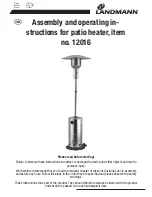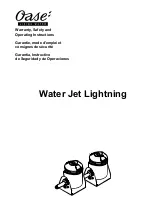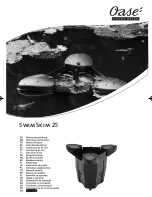
14
Instructions for use and maintenance
EN
IV.
DESCRIPTION AND PRINCIPLE OF WORK
The appliance consists of a body, flange at the bottom side
/for water heaters intended for vertical mounting/ or at the
sides /for water heaters intended for horizontal mounting/,
protective plastic panel safety-return valve.
1.
The body consists of a steel reservoir (water tank)
and housing (outer shell) with thermal insulation placed
in-between made of ecologically clean high density
polyurethane foam, and two pipes with thread G ½ ‘’ for cold
water supply (marked by a blue ring) and hot water outlet
pipe (marked by a red ring).
The inner tank may be of two types depending on the model:
•
Made of steel protected form corrosion by a special
glass-ceramics coating
•
Made of stainless steel
The vertical water heaters may be outfitted with a built in
heat exchange unit (boiler tube). The boiler tube’s entrance
and exit are located at the sides and represent pipes with
thread G ¾ ‘’.
2.
The flange is outfitted with: electric heater and
thermostat. The water heaters with glass-ceramics coating
are outfitted with a magnesium protector.
The electric heater is used for heating the water in the tank
and is managed by the thermostat, which automatically
maintains the set temperature.
The thermostat has a built in overheating safety device,
which switches of power to the heater when the water
temperature reaches excessive values.
3.
The safety-return valve prevents the appliance’s
complete emptying in the event the cold water supply is
interrupted. The valve protects the appliance from pressure
increases higher than the allowed value during heating (!
pressure increases upon an increase of temperature), via
release of excess pressure during the drainage opening.
The safety-return valve cannot protect the appliance in the
event of water mains pressure in excess of the acceptable
pressure stated for the appliance.
V.
MOUNTING AND SWITCHING ON
Attention! Improper installation and connection of the
appliance may make it hazardous for the health and life of
consumers. It may cause grievous and permanent
consequences, including but not limited to physical injuries
and/or death. Improper installation and connection of the appliance may
also lead to damage to the consumers’ property /damage and/ or
destruction/, or to that of third persons, as a result of, but not limited to
flooding, explosion and/or fire.
Installation, connection to the main water and power supply, and
putting into operation must be carried out by certified electricians and
technical personnel certified in installation of this category of appliances,
who have obtained their license in the state where the installation and
commissioning of the appliance are carried out, and in compliance with
its local legislation.
1.
Mounting
We recommend the mounting of the device at close
proximity to locations where hot water is used, in order
to reduce heat losses during transportation. In the event
the device is mounted in a bathroom, the selected
location must exclude the possibility of water spray
contact from the showerhead or portable showerhead
attachment.
The appliance is affixed to a wall via the mounting
brackets attached to the unit’s body (if the brackets are
not attached to the unit’s body, they must be affixed in
place via the provided bolts). Two hooks are used for
suspending the appliance (min. Ø 10 mm) set firmly in
the wall (not included in the mounting set).
•
The mounting bracket’s construction designed
for water heaters intended for vertical mounting is
universal and allows a distance between the hooks of
220 to 310 mm (fig. 1a).
•
For water heaters intended for universal (vertical and
horizontal) mounting, the distances between the hooks
vary for the different models and are specified in the
table 2 to Fig. 1b.
In order to prevent injury to user and third persons in the
event of faults in the system for providing hot water, the
appliance must be mounted in premises outfitted with floor
hydro insulation and plumbing drainage. Don’t place
objects, which are not waterproof under the appliance under any
circumstances. In the event of mounting the appliance in premises not
outfitted with floor hydro insulation, a protective tub with a plumbing
drainage must be placed under the appliance.
NOTICE: THE SET DOES NOT INCLUDE A
PROTECTIVE TUB AND THE USER MUST SELECT
THE SAME.
2.
Water heater connection to the pipe network
.
Fig. 4 - Where: 1 - Inlet pipe; 2 - Safety valve; 3 - reducing
valve (for water main pressure > 0,6 MPa); 4 - Stop valve;
5 - Funnel connected to the sewer network; 6 – Hose;
7 - Drain water tap.
Upon connecting the water heater to the water mains
you must consider the indicative color markings /rings/
affixed to the pipes: blue for cold /incoming/ water, red
for hot /outgoing/ water.
The mounting of the safety return-valve supplied with
the water heater is obligatory. The safety return-valve
must be mounted on the cold water supply pipe, in
observance of the direction arrow stamped on its body,
indicating the incoming water’s direction. Additional
stopcocks must not be mounted between the safety
return-valve and the water heater.
Exception: If the local regulations (norms) require the
usage of another protection valve or mechanism (in
accordance with EN 1487 or EN 1489), then it must be
bought additionally. For mechanisms operating in
accordance with EN 1487 the announced operational
pressure must be no more than 0.7 MPa. For other
protection valves, the pressure at which they are
calibrated must be 0.1 MPa lower than the one marked
on the appliance’s sign. In these cases the safety valve
which the appliance is supplied with should not be used.
The presence of other /old/ safety return-valves may lead
to a breakdown of your appliance and they must be
removed.
Other type of stopping armature is not allowed between the
protection return valve (the protective device) and the
appliance.
The attaching of the safety return-valve to threads longer
than 10 mm is not allowed, otherwise this may damage the
valve and poses danger for your appliance.
With boilers for vertical assembly, the safety valve has to be
connected to the ingoing pipe with the safety plastic panel of
the appliance being taken off. After it has been assembled it
should be in position as shown on Fig. 2.
The safety valve and the pipe between the valve and the
water heater must be protected from freezing. During hose
draining - its free end must be always open to the
atmosphere (not to be immersed). Make sure that the hose is
also protected from freezing.
Opening the cold-water stopcock of the water supply
piping network and opening the hot-water stopcock
of the water-mixing faucet carries out the filling of the
water heater with water. After the filling is complete, a
constant stream of water must begin to flow from the
water-mixing faucet. Now you can close the hot water
stopcock.
Содержание 100 RS
Страница 23: ...3 4 TR TS TR TS 3ⓐ 3ⓑ ...










































